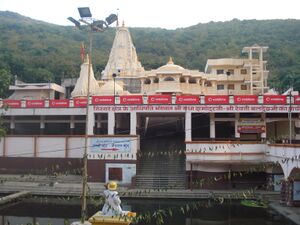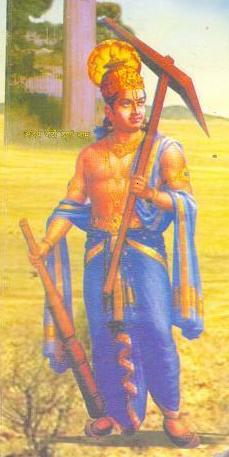Balarama
Balarama (बलराम) Balrama (बलराम), also known as Baladeva, Balabhadra and Halayudha and Haldhar (हलधर), is the elder brother of the divine being, Krishna.
Revati, the wife of Balarama
Revati (रेवती), daughter of Kukudmi, was wife of Balarama, the elder brother of Krishna.
An avatar of Vishnu
Within Vaishnavism and a number of South Indian, Hindu traditions Balarama is worshipped as an avatar of Vishnu, and is also listed as such in the Bhagavata Purana[1]. Within both the Vaishnava traditions and Hinduism generally he is acknowledged as being a manifestation of Shesha, the divine serpent on whom Vishnu rests.
Balarama took birth as the son of Vasudeva (वसुदेव) and Devaki. Kamsa, the brother of Devaki was an evil king, who was intenting upon killing all the progeny of his sister because of a prediction that he would die at the hands of her eighth son. Kamsa thus threw his sister Devaki and her husband Vasudeva into prison, and proceeded to kill each of their children as soon as they were born.
In due course of time, Devaki became pregnant for the seventh time. However, this child was not destined to meet the fate of the six previous infants. The unborn child was miraculously transferred from Devaki's womb to the womb of Rohini Devi, who had desired a child of her own. Thus Balarama's other name is also Sankarsana which describes the transfer of the child from the womb. The child was formally named Rama, but because of his great strength he was called Balarama (Strong Rama).
Thus, Rohini actually gave birth to Balarama and raised him. Balarama spent his childhood as a cowherd boy with his brother Krishna and friends.
Damodar Kund & Revati Kund Junagarh

- Damodar Kund & Revati Kund - Built in 500 A.D., this often reconstructed kund (water reservoir) is a check dam. This kund is about a km before the bottom of Girnar Hill. It is a sacred bathing tank. Close to Damodara Kund is Revati Kund. It is said that Revata left Dwarka and moved near Girnar Hill after his daughter, Revati, married Lord Balarama.
History
Some people in Greece consider Balram, brother of Lord Krishna as their ancestor. Yunan, the other name of Greece is after the name of Chandra Vanshi King Yavan who was from Satjit branch of Yadu.[2]
James Todd[3] writes... The Yadu was the most illustrious of all the tribes of Ind, and became the patronymic of the descendants of Budha, progenitor of the Lunar (Indu) race. Yudhishthira and Baladeva, on the death of Krishna and their expulsion from Delhi and Dwaraka, the last stronghold of their power, retired by Multan across the Indus. The two first are abandoned by
[p.102]: tradition ; but the sons of Krishna, who accompanied them after an intermediate halt in the further Duab1 of the five rivers, eventually left the Indus behind, and passed into Zabulistan,2 founded Gajni, and peopled these countries even to Samarkand......
- 2 [This is very doubtful.]
Jat clans descended from Balarama
घोसुंडी
विजयेन्द्र कुमार माथुर[4] ने लेख किया है ... घोसुंडी (AS, p.313) राजस्थान का एक ऐतिहासिक स्थान है। यह स्थान ऐतिहासिक दृष्टि से महत्त्वपूर्ण है। इस स्थान से शुंग कालीन अभिलेख प्राप्त हुए हैं। अभिलेखों से ज्ञात होता है कि द्वितीय शती ई. पू. के लगभग ही देश के इस भाग में भागवत धर्म (वासुदेव कृष्ण की पूजा) का प्रचलन प्रारंभ हो गया था और बौद्ध धर्म अवनति के मार्ग पर बढ़ रहा था। एक अभिलेख में सकर्षण या बलराम की उपासना का भी उल्लेख है।
जाटों का यूरोप की ओर बढ़ना
ठाकुर देशराज[5] ने लिखा है .... हूणों के आक्रमण के समय जगजार्टिस और आक्सस नदियों के किनारे तथा कैस्पियन सागर के तट पर बसे हुए जाट यूरोप की ओर बढ़ गए। एशियाई देशों में जिस समय हूणों का उपद्रव था, उसी समय यूरोप में जाट लोगों का
[पृ.154]: धावा होता है। कारण कि आंधी की भांति उठे हुए हूणों ने जाटों को उनके स्थानों से उखाड़ दिया था। जाट समूहों ने सबसे पहले स्केंडिनेविया और जर्मनी पर कब्जा किया। कर्नल टॉड, मिस्टर पिंकर्टन, मिस्टर जन्स्टर्न, डिगाइन, प्लीनी आदि अनेक यूरोपियन लेखकों ने उनका जर्मनी, स्केंडिनेविया, रूम, स्पेन, गाल, जटलैंड और इटली आदि पर आक्रमण करने का वर्णन किया है। इन वर्णनों में में कहीं उन्हें, जेटा, कहीं जेटी, और कहीं गाथ नाम से पुकारा है। क्योंकि विजेता जाटों के यह सारे समूह ईरान और का कैस्पियन समुद्र के किनारे से यूरोप की ओर बढ़े थे। इसीलिए यूरोपीय देशों में उन्हें शक व सिथियन के नाम से भी याद किया गया है। ईरान को शाकद्वीप कहते हैं। इसीलिए इरान के निवासी शक कहलाते थे। यूरोपियन इतिहासकारों का कहना है कि जर्मनी की जो स्वतंत्र रियासतें हैं, और जो सैक्सन रियासतों के नाम से पुकारी जाती हैं। इन्हीं शक जाटों की हैं। वे रियासतें विजेता जाटों ने कायम की थी। हम यह मानते हैं और यह भी मानते हैं कि वे जाट शाकद्वीप से ही गए थे। किंतु यूरोपियन लेखकों के दिमाग में इतना और बिठाना चाहते हैं कि शाल-द्वीप में वे जाट भारत से गए थे। और वे उन खानदानों में से थे जो राम, कृष्ण और यदु कुरुओं के कहलाते हैं।
यूरोप में जाने वाले जाटों ने राज्य तो कायम किए ही थे साथ ही उन्होंने यूरोप को कुछ सिखाया भी था। प्रातः बिस्तरे
[पृ.155]: से उठकर नहाना, ईश्वर आराधना करना, तलवार और घोड़े की पूजा, शांति के समय खेती करना,भैंसों से काम लेना यह सब बातें उन्होंने यूरोप को सिखाई थी। कई स्थानों पर उन्होंने विजय स्तंभ भी खड़े किए थे। जर्मनी में राइन नदी के किनारे का उनका स्तंभ काफी मशहूर रहा था।
भारत माता के इन विजयी पुत्रों ने यूरोप में जाकर भी बहुत काल तक वैदिक धर्म का पालन किया था। किंतु परिस्थितियों ने आखिर उन्हें ईसाई होने पर बाध्य कर ही दिया। यदि भारत के धर्म प्रचारक वहां पहुंचते रहते तो वह हरगिज ईसाई ना होते। किंतु भारत में तो सवा दो हजार वर्ष से एक संकुचित धर्म का रवैया रहा है जो कमबख्त हिंदूधर्म के नाम से मशहूर है। उनकी रस्म रिवाजों और समारोहों के संबंध में जो मैटर प्राप्त होता है उसका सारांश इस प्रकार है:-
- जेहून और जगजार्टिस नदी के किनारे के जाट प्रत्येक संक्रांति पर बड़ा समारोह किया करते थे।
- विजयी अटीला जाट सरदार ने एलन्स के किले में बड़े समारोह के साथ खङ्ग पूजा का उत्सव मनाया था।
- जर्मनी के जाट लंबे और ढीले कपड़े पहनते थे और सिर के बालों की एक बेणी बनाकर गुच्छे के समान मस्तक के ऊपर बांध लेते थे।
- स्केंडिनेविया की शिवि और शैवी जाट हरगौरी और धरतीमाता की पूजा किया करते थे। उत्सव पर वे हरिकुलेश और बुद्ध की प्रशंसा के गीत गाते हैं।
- उनके झंडे पर बलराम के हल का चित्र था। युद्ध में वे शूल (बरछे) और मुग्दर (गदा) को काम में लाते थे।
- वे विपत्ति के समय अपनी स्त्रियॉं की सम्मति को बहुत महत्व देते थे।
- उनकी स्त्रियां प्रायः सती होने को अच्छा समझती थी।
- वे विजिट लोगों को गुलाम नहीं मानते थे। उनकी अच्छी बातों को स्वीकार करने में वे अपनी हेटी नहीं समझते थे।
- लड़ाई के समय वे ऐसा ख्याल करते थे कि खून के खप्पर लेकर योगनियां रणक्षेत्र में आती हैं।
बहादुर जाटों के ये वर्णन जहां प्रसन्नता से हमारी छाती को फूलाते हैं वहां हमें हृदय भर कर रोने को भी बाध्य करते हैं। शोक है उन जगत-विजेता वीरों की कीर्ति से भी जाट जगत परिचित नहीं है।
External Links
References
- ↑ Bhag-P 1.3.23 "In the nineteenth and twentieth incarnations, the Lord ad-vented Himself as Lord Balarama and Lord Krishna"
- ↑ Ram Sarup Joon: History of the Jats/Chapter III, p.41
- ↑ James Todd Annals/Chapter 7 Catalogue of the Thirty Six Royal Races,p.101-102
- ↑ Aitihasik Sthanavali by Vijayendra Kumar Mathur, p.313
- ↑ Thakur Deshraj: Jat Itihas (Utpatti Aur Gaurav Khand)/Navam Parichhed,p.153-156
